Caistor, Lincolnshire
Up to 1834
A parliamentary report of 1777 recorded a parish workhouse in operation at "Market Raisin" for up to 17 inmates.
In 1800, a "Society of Industry" was formed at Caistor by William Dixon. The objects of the society were to:
The Society established a Gilbert's Union of 52 constituent parishes, making it one of the largest such unions in the country. In 1800-2 a workhouse was erected to the west of Caistor on nine acres of land donated to the Incorporation by the Lord of the Manor and freeholders of Caistor.
An 1803 report by Dixon described the workhouse as an:
The three-storey U-shaped building was one of the earliest workhouses to include a central hub from which the workhouse master could supervise the inmates' yards — for males at the west, and females at the east.
In 1803, the still incomplete building accommodated 24 adults and 18 children. The children knitted and spun woollen yarn. In 1820, it was reported that a stock of 'wool, yarn, flax, thread etc... with proper machinery' was maintained at the workhouse.
After 1834
Following the passing of the 1834 Poor Law Amendment Act, Caistor Incorporation was dissolved and replaced by a new Poor Law Union which officially came into being on 13th November 1836. Its operation was overseen by an elected Board of Guardians, 80 in number, representing its 76 constituent parishes as listed below (figures in brackets indicate numbers of Guardians if more than one):
County of Lincoln: Ashby-cum-Fenby, Aylesby, Atterby, Barnoldby-le-Beck, Beelsby, Bigby, Bishop Norton, Bradley, Brigsley, Buslingthorpe, Caibourn, Caistor (2), Claxby, Clee, Cleethorpe, Clixby, Grat Coates, Little Coates, Croxby, Cuxwold, Glentham, Grapby, Great Grimsby (3), Haborough, Hatcliffe, Hawerby with Beesby, Healing, Holton-le-moor, Humberton, Immingham, Irby, Keelby, North Kelsey, South Kelsey, Kingerby, Kirmoud-le-mire, Laceby, Legesby, Lessington, Limber Manga, Limber Parva with Brocklesby, Linwood, Market-Rasen (2), Middle-Rasen, Nettleton, Newton-by-Toft, Normanby-on-the-Wold, Osgodby with Kirkby, North Owersby, South Owersby, West Rasen, East Ravendale, West Ravendale, Riby, Rothwell, Scartho, Searby-cum-Owmby, Six Hills, Snitterby, Somerby, Stainton-le-Vale, Stallingborough, Swallow, Swinhope, Tealby, Thoresway, Thorganby, Thornton-le-moor, Toft, East Torrington, Usselby, Walesby, Waltham, Wold Newton, Waddingham, North Willingham.
The population falling within the union at the 1831 census had been 23,919 with parishes ranging in size from West Ravendale (population 26) to Great Grimsby (4,225) and Caistor itself (1,525). The average annual poor-rate expenditure for the period 1834-36 had been £4,172 or 9s.7d. per head.
The new Caistor Union took over the existing Caistor workhouse. In 1837-8 for the Poor Law Commissioners authorized an expenditure of £1,745 for various alterations and enlargements — this may have included the single-storey entrance black at the north of the main workhouse. Further additions were made 1842 for which a further £380 was authorised. Separate fever wards were added, followed in 1863-4 by a school with master's house attached, and in 1865-6 by a 200-seat chapel, dedicated to St Lawrence. The workhouse graveyard lay to the west of the chapel. An infirmary was erected at the east of the workhouse in 1871.
The workhouse location and layout can be seen on the 1905 map below.
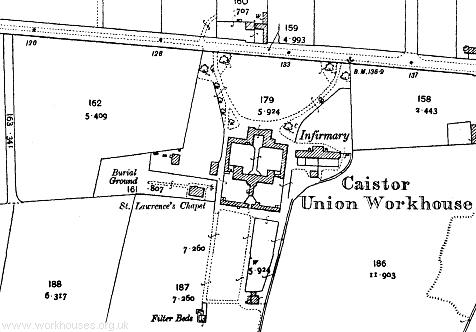
Caistor workhouse site, 1905.
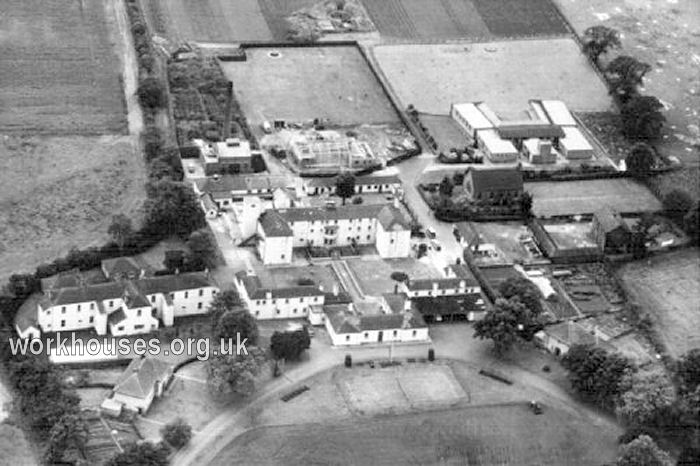
Caistor workhouse aerial view from the north-east.
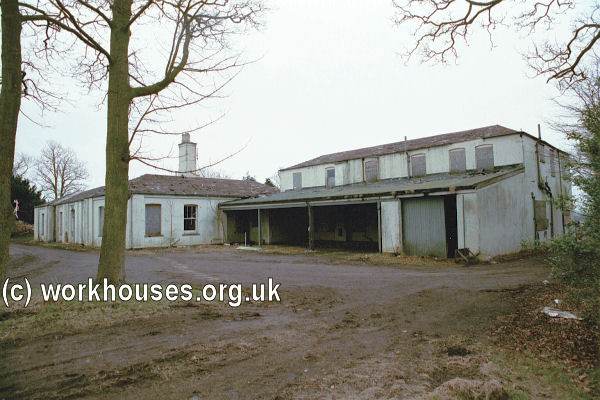
Caistor entrance block from the north-west, 2001.
© Peter Higginbotham.
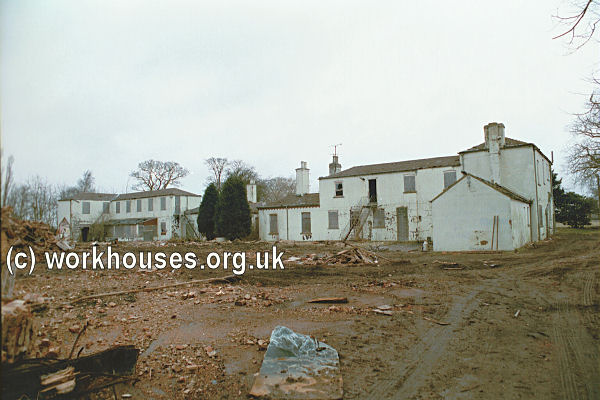
Caistor entrance block from the south, 2001.
© Peter Higginbotham.
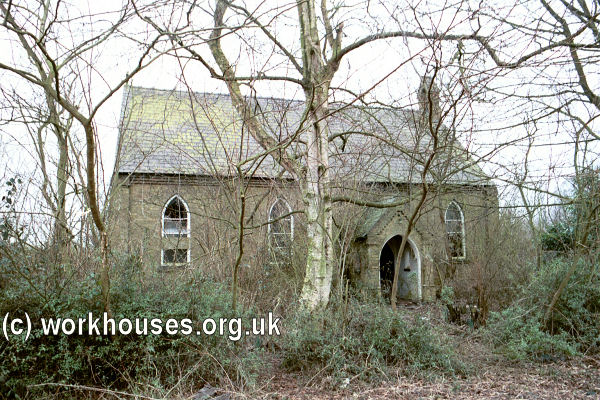
Caistor chapel from the north, 2001.
© Peter Higginbotham.
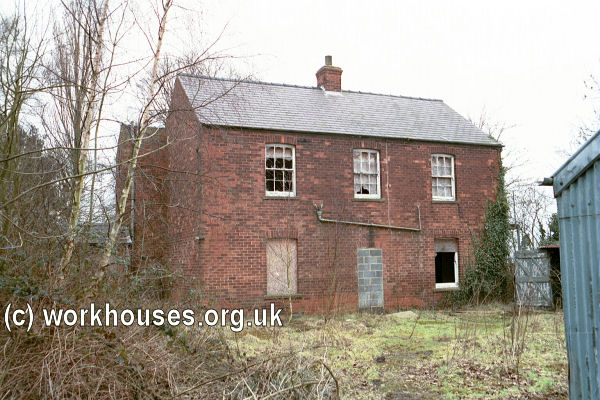
Caistor school-block(?) from the east, 2001.
© Peter Higginbotham.
In the early 1900s, the Master and Matron of the workhouse were Mr and Mrs Solomon. The picture below shows them and their staff in 1905.
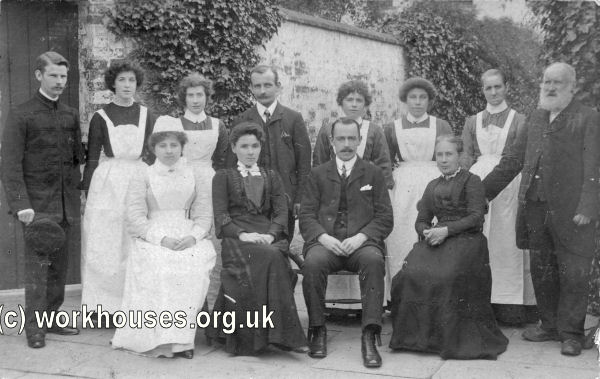
Mr and Mrs Solomon and workhouse staff, 1905.
© Peter Higginbotham.
Another picture from the same period shows the workhouse dining-hall arranged for Christmas festivities.
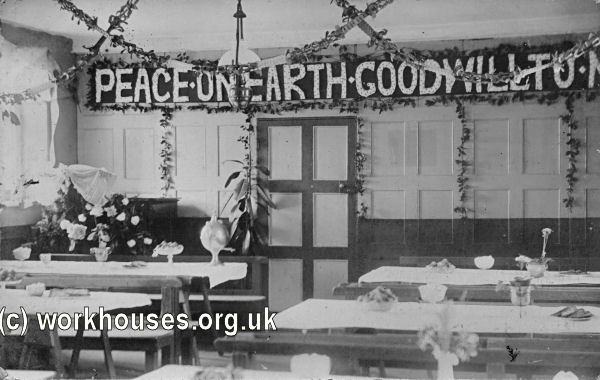
Caistor workhouse dining-hall, Christmas 1905.
© Peter Higginbotham.
In 1897, it was reported that the inmates from within the Caistor Union filled barely a quarter of the workhouse. Accordingly, the Guardians were now providing accommodation in the workhouse to paupers placed by other Unions, such as Brigg, Halifax and Nottingham, whose own workhouses were short of space.
By the 1880s, the Caistor Union had established casual wards at Chapman Street, Market Rasen, for the overnight accommodation of tramps and vagrants. The site later became The Poplars 'hostel'.
In the 1930s, the workhouse site became Caistor Certified Institution for "mental defectives" and various additions were made to the accommodation. In April, 1937, management of the premises was transferred to the Lincolnshire Joint Board for the Mentally Defective. Patients were temporarily transferred to the Holbeach Institution in 1937 while the Caistor premises were modernised, and returned in January 1938. In the 1940s, the establishment was sometimes known as the Caistor Branch of the Harmston Hall Colony.
In 1948, the site became part of the new National Health Service under the name Caistor Hospital which continued in operation until 1990. The premises then remained empty and were seriously damaged by a fire in 2001 resulting in the demolition of most of the buildings, leaving only the front block, chapel, and school block. The site is now covered by the Roams Walk housing development and none of the workhouse buildings remains.
Staff
Inmates
Records
Note: many repositories impose a closure period of up to 100 years for records identifying individuals. Before travelling a long distance, always check that the records you want to consult will be available.
- Caistor Union Outdoor relief list March-September 1900
- Lincolnshire Archives, St. Rumbold Street, Lincoln LN2 5AB. Limited holdings include Guardians' minute books (1836-1931 with gaps); Register of Bastardy orders (1881-1906).
Bibliography
- Rawding, C. (1987) The Poor Law Amendment Act 1834-5: Case study of Caistor Poor Law Union by (Lincs. Hist. and Arch. Jnl. 22)
- Russell, Rex; Frankish, Alan; Frankish Pat Caistor Hospital: From House of Industry to Caistor Hospital 1802-1990
- Udell, Joanne (2005) The Legacy of the Workhouse - Harsh Prison or Popular Myth (The Lincolnshire workhouse regime with investigation into Louth and Caistor workhouses 1834-1925. Illustrated, pp.38). Copies available at £5 (plus £1.50 UK postage for a single copy, or £1.80 for up to 3 copies). Please make cheques payable to Mr. R.I.Dickinson at The Hollies, 27 Station Road, Stallingborough, Grimsby DN41 8AQ. (Email enquiries to jill.mason@btinternet.com)
Links
Unless otherwise indicated, this page () is copyright Peter Higginbotham. Contents may not be reproduced without permission.


